Post #1
Intro
Visual Reflexology is a way of foot reading based totally on modern Western reflexology (Ingham method and similar). Other ways of reading the feet based on or incorporating the use of methodologies such as Yin/Yang, Chakras, the natural elements etc., have already been written about extensively elsewhere and are not included.
This is in order to encourage the development of foot reading based on our own therapy. And also to make the reasoning behind it understandable to all reflexologists, the majority of whom have little or no training in these other methodologies. Once a reflexologist has an understanding of Visual Reflexology this can be used on its own or in combination with other ways of foot reading.
As reflexology is a bodywork therapy, I cover the physical aspect of reading the feet first. This then gives a holistic insight into the health of other forms of energy, because – naturally – physical, emotional, mental and spiritual imbalances all replicate in how they manifest visually on the feet. Alongside reading the health of individual reflexes, problems with the functioning of systems of the body (lymphatic, musculoskeletal, venous, etc.,) which usually develop in areas of the body, are read over corresponding areas of the foot.
To learn more about how I read the feet and reached the conclusions below, as well as how to apply this knowledge during a treatment, read my ebook
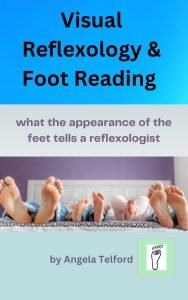
Recent posts
Feet of the Month #1
In this post, I will read the feet looking only for visual indications of health problems reported by the client. Of course, (as with the textures we feel), feet also show evidence of other issues that the person has not mentioned for whatever reason, but I will not read these here.
In contrast, in some upcoming posts, I will do the opposite and read the feet without any reference to the client’s notes. This teaches us to not be over-reliant on known medical history, but to work holistically with an open mind while looking at the feet.
Client:
Female 59, single, no children, semi-retired, runs a letting agency and does voluntary work. Swims, plays tennis, walks, weekly Chi Gong & Pilates. Regular reflexology and massage for the last 10 years and occasional osteopathy. Good diet, social drinking – few units a week, non-smoker, very health conscious.
Medical History:
Aged 5 clean break of left calf, good recovery with no apparent residual issues. Aged 11 broke left humerus, and has lacked full elbow rotation since.
Aged 42 had a rectal prolapse with emergency partial colectomy of the ascending colon. Aged 43 further emergency surgery for kink in small intestine with 5 cm removed. Diverticulitis is still present but under control, and digestion is generally good. Aged 45 reconstructive surgery for two abdominal hernias. Caught MRSA in hospital during this time but recovered.
Has a weak oesophageal valve, and a year ago had months of constant burping with no identifiable cause. This has settled now and only occurs if she has fizzy drinks.
Aged 49 had a mitral valve replacement but recovered well and current heart function is good.
Prone to hay fever and sometimes uses a non-steroidal nasal spray. 5 years ago had a perforated left ear drum which recovered well but occasionally troubles her, especially if she has hay fever or a cold.
Non-specific chronic pelvic girdle tightness causes lower back issues. Scar tissue from an old skiing accident led to 5 slightly ‘stuck’ cervical vertebrae occasionally causing pain in the right neck and shoulder. A cyst that developed recently behind her right knee, has reduced of its own accord. A right lower intercostal muscle pulled a month ago has nearly recovered.
Emotional Wellbeing:
Chi Gong helps maintain her mental equilibrium but she is not inclined to discuss emotional issues at all, even though I have been her therapist for many years. This makes it very difficult to read and assess this aspect of her wellbeing. Superficially at least, she seems well balanced and happy. Both parents are deceased but she is close to her brother and godchildren and has many friends. Lives alone and seems content to do so with a busy social and professional life.
Her medical history has led to a lot of anxiety about her health and is aware this causes ‘controlling’ tendencies’ emotionally but takes a proactive approach to cope with this. She was prone to regular minor accidents but since partial retirement has become less distracted and more grounded and these have stopped.
Plantar Aspect (Right-Left)
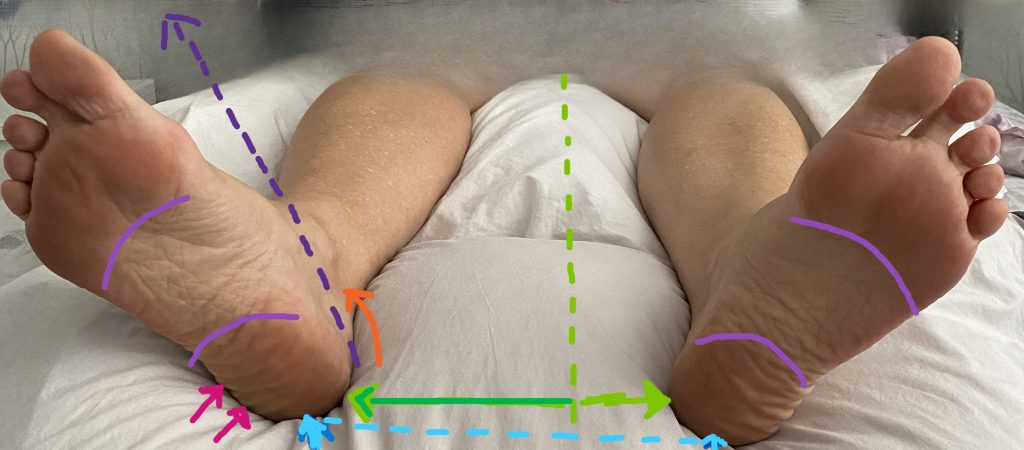
General Presentation and Overall Balance
(For easier study, enlarge the photo in your browser zoom – top right hand side)
When lying down, deviation from the anatomically correct foot alignment reflects tension in the leg muscles. which carries on up into the hip/pelvis and lower back. So the position and angle of the ankles provide a lot of information about misalignment in the musculoskeletal reflexes of the lower body.
1. The feet should lie hip-width apart, equidistant from the medial line. So her right foot lies a little too wide, showing a lateral pull on the leg muscles causing tension all the way up to the hip.
2. Both heels should be the same distance away from us but the right appears slightly further away. This may just be due to the foot lying wider, but could also show the right hip is higher meaning there is a horizontal pelvic tilt.
3. As the lateral thigh muscles are heavier than the medial, legs should roll slightly outwards with the ankles rotated to ’11 and 1 o’clock’ angles. But the right ankle is rotated a little too far from the ’11 o’clock’ angle. This also puts pressure into the hip joint along with a corresponding outward pull on the groin muscles which is also reflected in their reflexes. In her case causing chronic lower back tightness (possibly originating as far back as her childhood leg break).
Both feet have redness showing cell inflammation there in the heel reflex area. This includes the reflexes of the pelvis/gluteal muscles and the lower abdomen. And also over the metatarsals including the heart. This has undoubtedly been a factor in previous health issues and shows the need to continue preventative work in these areas.
Emotions and Personality, the distance between her feet, and relaxed ankle rotation indicate an open, confident straightforward person which she appears to be. Both feet look very similar, especially for her age, reflecting a well-balanced person who has adapted well to changes throughout her life. However, the extensive redness relates to inflamed emotions such as anger and irritation connected to those organs and areas of the body.
The arches are high (this is even clearer in the medial aspect reading below). This indicates an independent type of personality which may be best suited to working alone or in a position of responsibility and/or authority. Their weakness can be linked to pride or resistance to ask for and accept the support of others. This assessment fits well with her.

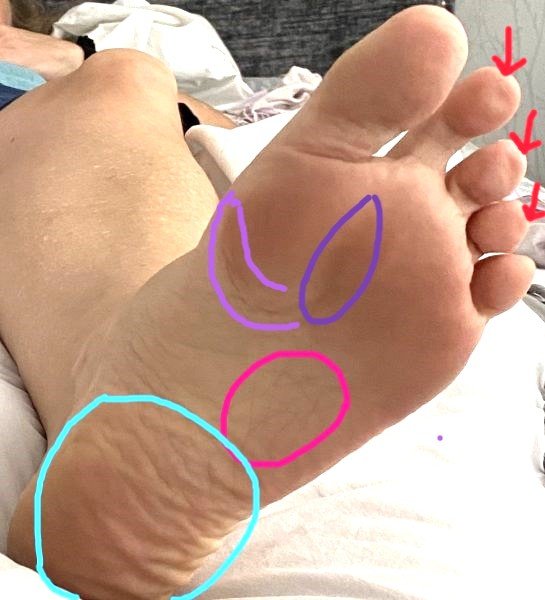
Individual foot assessments (Right-Left)
The right big toe shows the chronic neck misalignment caused by the tightness of the scar tissue is pulling her neck laterally to lean into toe 2. As a result, several vertical stress lines have formed along the toe neck. Right toes 3, and especially 4&5 are very bunched up reflecting hunching in the shoulder joint/girdle in these zones, connected to the tight neck, and right arm pain.
Several toe pads are puffy with a sunken dip indicating swollen, congested and blocked sinus reflexes (it was hay fever season). The left are worse, probably compounded by the lingering problems of her perforated eardrum.
Mentally, the toe swellings indicate repressed thoughts and emotions, fitting with her reluctance to discuss emotional issues. The toe shape differences, and irregular alignments i.e. gaps and overlaps, reflect disharmony and conflict in the thinking process. This relates to how accident prone she tends to be (although this has improved recently)
Between heart reflex zones 1-2 there is a dip in the texture of the underlying tissue created by a string of short stress lines, which causes a dark shadow. The lines are an obstruction to healthy blood and lymph flow and muscle function, connected to the mitral valve problem.
Emotionally, they show barriers to the expression of her feelings. The dip means sunken (repressed) emotions, and the shadow some darkness around them. Again her tendency to avoid contact with and repress her emotions is reflected.
Digestive tract problems are very evident. A short deep stress line crosses the right stomach reflex, possibly connected to the weak oesophageal valve. More parallel lines indicating pathogenic overgrowth presumably related to the burping, run over the right stomach, pancreas & liver zone 3, and also curve over the left stomach, one continuing up to the diaphragm.
Multiple stress lines crisscross the small intestines zones 3-4 on both feet and into the liver on the right. There is a deep line at the hepatic flexure where the incisions from the colectomy were made. The lines on the left are not as deep. The skin over the lower intestines and pelvic area looks loose and ‘rippled’ especially on the left, showing a connective tissue problem here, and therefore in this area of the body.
Emotionally, the digestive tract relates to processing good things in life and allowing for self-nourishment. Often considered as relating to our relationship with our primary caregiver as an infant. Her heart problem occurred not long after her mother’s death
Dorsal Aspect (Left-Right)


Individual foot assessments (Left-Right)
(NB Visual Reflexology works with the understanding that energy travels through the foot/body so indications of internal reflex health can be seen on both aspects.)
A bunion starting at the right big toe MTP joint reflects the chronic lateral pull on the neck & upper spine caused by the ‘stuck’ vertebrae. This pull is also affecting the angle of the nail growth.
Stress lines show tension across the mid-face (mouth/jaw) reflex on both big toes which is an impediment to sinus drainage. As is an obstruction to the flow of the upper lymph caused by tightness across her neck-shoulder girdle because she is hunching forward. This is reflected in the dorsiflexion of toes 2-5 at the MTP joints, and is more noticeable the right than left.
The tightness in both of the big toe tendons reflects tension in the muscles of the anterior body. This impacts the functioning of the entire zone 1 digestive tract reflexes. From the throat past the oesophagus and stomach down to the transverse colon. And very tight ankle tendons reflect tension in the lower abdomen impacting the lower region of the small intestines.
It is likely nerve trauma causes freckles to develop, and she finds gentle linking from the freckle in the right stomach zone 1 to the equivalent spot on the plantar foot to be very relaxing. Just below this, a distended vein curves from the stomach over the horizontal colon to the intestines, meaning the body is struggling to pump blood through this area in the body.
Emotionally, hunching forward on the shoulder girdle shows vulnerability, protecting the heart and also making oneself smaller. The stress lines across the face show tension from holding back the verbalisation of thoughts. And nails are a window between our thoughts and how we communicate them to the world. The crooked nail shows a misalignment between the two.
Medial Aspect (Right-Left)
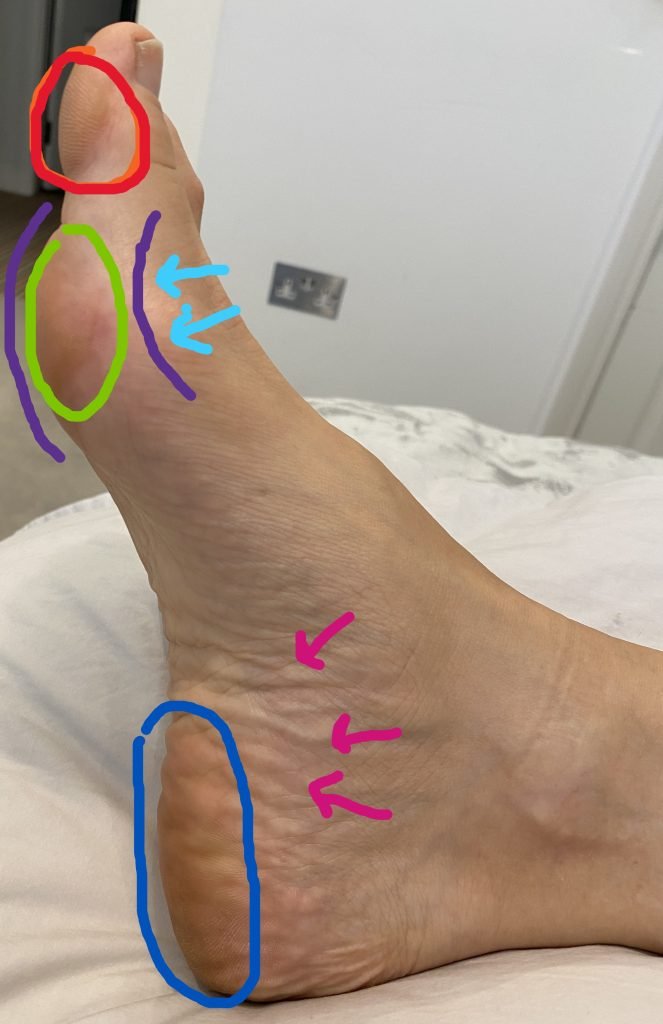

The lateral pull on the right big toe causes its medial edge to rub against the inner shoe. From this aspect, we can see that as a result hard dry skin has built up on there. Muscle tightness also inhibits lymph flow and this is reflected in the dry skin, often with the resultant yellow tinge of toxicity as seen here. In reflex terms, the inadequate lymph supply is preventing toxins from being eliminated efficiently.
The hard skin lies over brain zone 1 mainly the cerebellum reflex, so is a barrier to putting thoughts into action, and also balance and equilibrium as it is over where the nerves cross over to the other side of the body. It also continues through to cover the internal nose area and therefore sinus drainage.
The prominent balls of the feet reflect her curved upper spine and hunched posture. This impacts the blood and lymph flow, and muscle function around the heart and stomach, as well as their nerves which leave through the vertebrae. And the cell inflammation is very clear.
Below the redness along the medial heel hard skin with a slightly yellowish tinge is also visible. So inflammation, poor lymph supply and toxicity all affect the lower back, pelvis and groin.
The loose skin of the soles of the heels is visible carrying on to the spine so this will also impact the nerves of the digestive reflexes that leave from this area. And there are some peizogenic papules which are herniated tissue, so indicate weakness in the reflex areas on which they appear i.e. her left lower spine and pelvic floor.
Emotionally, hard skin at the medial edge of the big toe is a shield, an attempt to protect. But it forms a barrier to the flow of thoughts between the two lobes of the brain and mental and emotional harmony. The yellowish tinge indicates some toxicity in the content of the thoughts. It also shows an obstruction between the brain and central nervous system manifested in difficulty in putting one’s thoughts into action.
Weakness in the lower back means a lack of support at our base, possibly related to our foundation i.e. family, upbringing and the community in which we grew up.
Lateral Aspect (Right-Left)
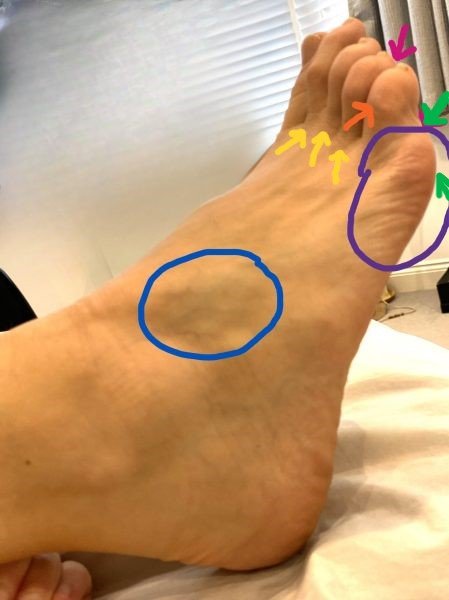

Tightness in both toes 5 causes a bunched appearance reflecting tension in the shoulder joints. On the right foot, the MTP joint of toe 5 is also very curved, and there is a callous over the toe. Both are further evidence of problems with the shoulder joint as a continuation of the shoulder girdle problem on the right. This is also shown by the greater degree of dorsiflexion of the other small toes compared to those on the left.
Multiple stress lines running down both arm reflexes reflect how the tension in the shoulder joints continues down the upper arms. But on the left foot, the lines continue a little further down towards the elbow reflex because of the old injury affecting this arm.
Some stress lines cut into the upper leg reflex on the left foot reflecting the tension in the hip and thigh. Bluish swellings on both feet over the dorsal small intestine reflex area zones 3-4 show poor lymph drainage in the area, Their bluish tinge also shows that the blood supply here is poorly oxygenated. Both of these were likely contributing factors in the historic health issues of the intestines and abdominal hernias.
The End.
(all photos used with the client’s permission)
copyright 2023 Angela Telford. All rights reserved.
Post #2 coming soon.
